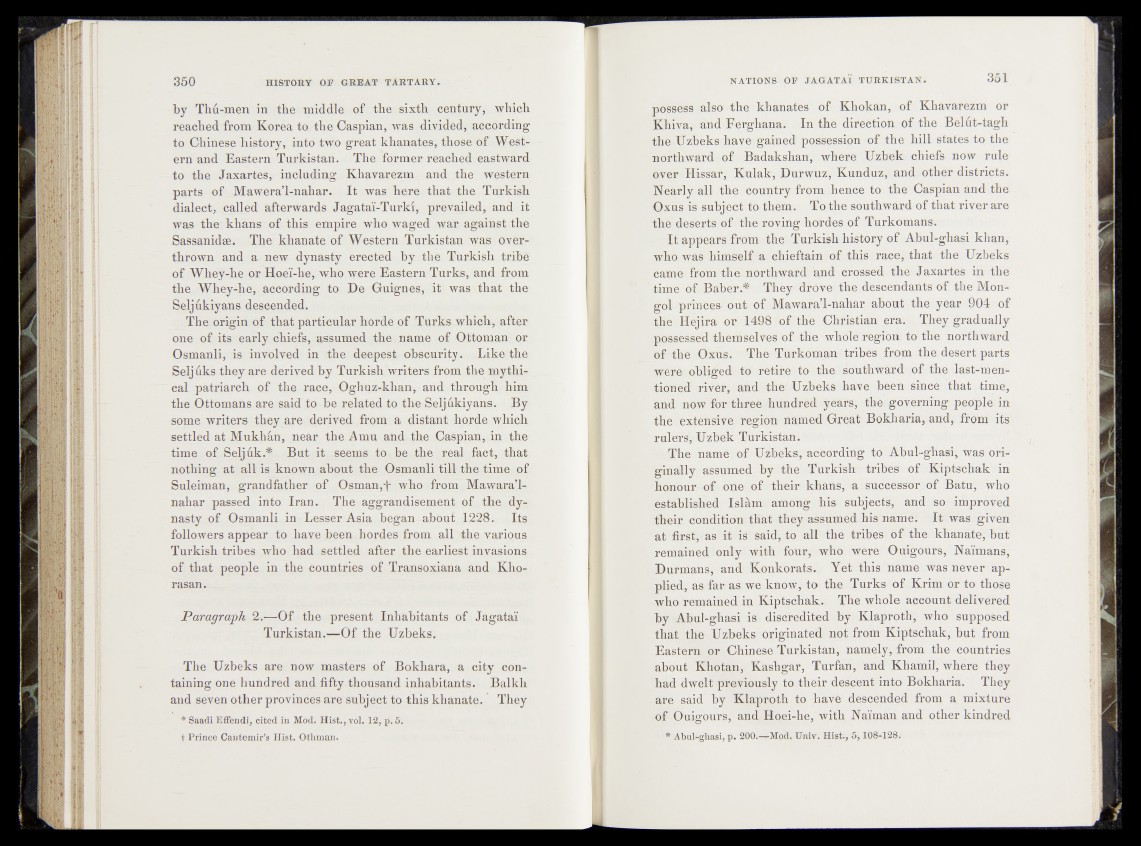
by Thu-men in the middle of the sixth ceptury, which
reached from Korea to theUlaspian, was divided, according
to Chinese history, into two great khanates-j those, of Western
and Eastern Turkistan. The former reached eastward
to the Jaxartes, including Khavarezm- and the western
parts of Mawera’l-nahar. It was here that the Turkish
dialect, called afterwards Jagatai-Turkl, prevailed, and |t
was the khans of this empire who waged war against the
Sassanid®. The khanate of Western Turkistan was over??1
thrown and a new dynasty erected by thp: Turkish tribe
of Whey-he or Hoei-he, who were Eastern Turks, and from
the Whey-he, according to De Guignes,,^ was that the
Seljfikiyans descended.
The~origin of that particular horde of Turks which, after
one of its early chiefs, assumed the name of Ottoman or
Osmanli, is involved in the deepest* obscurity. Jukeiths
Splj uks they are derived by Turkish writers from the mythi^
cal patriarch of the race, Oghuz=khan, and%^hsnough hin$
the Ottomans are said to be related to thev-^jiikiyans. By
some writers they are derived from a distant hord^/which;
settled at Mukhan, near the Amu and the Caspian,,in the
time of Seljuk.# But it seems to. be the real fact, that
nothing at all is known about the Osmanli till the time, of
Suleiman, grandfather of Osman,^ who :from Mawarall-
nahar passed into Iran. The aggrandisement of ^the^dynasty
of Osmanli in Lesser Asia began^about^^23.' Its
followers appear to have been hordes from all bhe various
Turkish tribes who had settled after the earliest invasions,
of that people in the countries of Transoxiana and Khurasan....
paragraph —Of the present Inhabitants of Jagatai
Turkistan.—Of the Uzbeks.
The Uzbeks are now masters of Bokhara, a city containing
one hundred and fifty thousand inhabitants. Balkh
and seven other provinces are subject to this khanate. They
* Saadi Effendi, cited in Mod. Hist., vol. IS, p. 5.
t Prince Cantemir’s Hist. Othman.
possess alSO' the khanafiSf of Khokan, of Khavarezm or
Khiva^and Ferghana. In the direction of the Belut-tagh
the Uzbeks havergained! .possession of the hill states to the
northward of Badakshan, where Uzbek chiefs now rule
over H-isshr,* Kulpk, Durwuz, Kunduz, and other districts.
?|i&4aTly;aH ^HeMfcountry from ^ep^e «to the Caspian and the
Oxus is subject to them. Tottjiefsjemthward of that river are
the debris of the rovJ'F^ho'rdbs of Turkomans*.*
It appears from ptfe Turkishjhistory of Abul-ghasi khan,
who was himself'a chieftain of -thislirace^that the Uzbeks
came frlfn the '-noriRjwat^ and8 crossed the Jaxartes in thef
time Of, Ba%er.^ TheyndrOVerrthe descendants of the Mon-*
go! prirjcewoutpf Mawara’l-nahar about the year 904 of
tfie Hejira or 1498 of;-the .Christian eraf; They gradually
Assessed' thenik#I'vesfof the whdl<! Yegibri^fo” the northward
offthe Oxus. The Turkoman tribes from the deseft parts
were obliged to retire* to ^the*<southward#l the last-men-^
tioned riven, and the! Uzbeks have beenisipce that time,
and. now” for three hundred years, thasgoverning people in
thb^eitehsive region named Great Bokharia, and, from its'
Uzbek Turkistan.
The name^F Uzbeks, according to Abul-ghasi, was originally
assumed by the Turkish tribes of Kiptschak in
honour-of one of their khans, a. suCeesSor b^ Batu, who
established Isl&m among his subjects, and so improved
their condition that they assumed his namieF It was given
at first, as it is said, to all the tribes of the khanate, but
remained only with-four, who were Ouigours, Kalmans,
Durmans, and Konkorats. Yet this name was never applied,
as far as we know, to the Turks of Krim or to those
who Remained in Kiptschak. The whole account delivered
by Abul-ghasi is discredited by Klaproth, who supposed
that the Uzbeks originated not from Kiptschak, but from
Eastern or Chinese Turkistan, namely, from the countries
about Khotan, Kashgar, Turfan, and Khamil, where they
had dwelt previously to their descent into Bokharia. They
are said by Klaproth to have descended from a, mixture
of Ouigours, and Hoei-he, with Naiman and other kindred
* Abul-ghasi, p. 200.-rMpd, Uiiiv. Hist., 5 , 108-128.